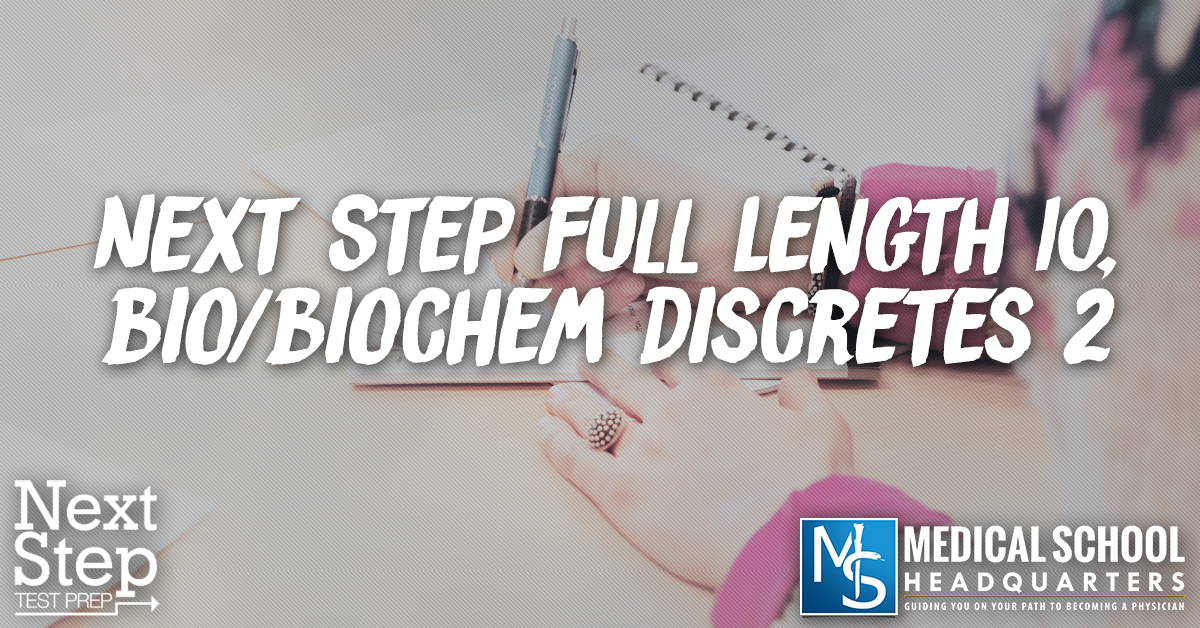Apple Podcasts | Google Podcasts

Session 125
In our next set of discrete questions from Blueprint MCAT (formerly Next Step Test Prep), we talk about insulin, beta-oxidation, and the IRB and research process. Follow along in the post.
Today, Clara from Blueprint MCAT (formerly Next Step Test Prep) joins us as we talk about bio/biochem from Blueprint MCAT (formerly Next Step Test Prep) full-length 10 practice exams.
Listen to all our other podcasts on MedEd Media Network including The Premed Years.
[02:52] Question 27
In what order do electrons move through the ETC?
- (A) From carriers with lower reduction potential to carriers with higher reduction potential.
- (B) From carriers with higher reduction potential to carriers with lower reduction potential.
- (C) From carriers with stronger proton-binding capacity to carriers with weaker proton- binding capacity.
- (D) From carriers with weaker proton-binding capacity to carriers with stronger proton- binding capacity.
Clara’s insights:
Because this is like a 2-in-2 question where two answer choices go together and then the other two go together as well. So it makes it relatively easy to eliminate two right off the bat if they’re not relevant. The reduction potential is the tendency of a compound to gain electrons. So A and B are relevant to electron transport. But C and D talk about proton binding capacity which is not going to be relevant to the electron transport chain.
The correct choice here is A. This is because reduction potential is a measure of what extent a compound wants to get reduced. A compound with lower reduction potential doesn’t have a very strong tendency to get reduced but a compound with a higher reduction potential does. The higher the reduction potential the more likely something is to grab on electrons. Reduce means the tendency to gain electrons.
[07:25] Question 28
All of the following are functions of insulin except:
- (A) Increasing glycogen synthesis
- (B) Increasing gluconeogenesis
- (C) Increasing glucose uptake by liver and muscles
- (D) Decreasing proteolysis
Clara’s insights:
B is the correct answer here. Whenever you see the suffix -lysis, you can think of breakdown. So proteolysis would be the breakdown of proteins. Literally, the only fact you needed to answer this is that insulin causes glucose to get stored in the cells and it doesn’t cause the opposite of that which is new glucose or new energy sources in the body. While proteolysis would be, for instance, you have plenty of proteins stored in muscle cells, proteolysis would be the break down of the muscle to form amino acids as an energy source. And we don’t need energy source if we have plenty of glucose in the digestive tract so an insulin function would be decreasing proteolysis.
[10:00] Question 29
In order to ensure approval by their Institutional Review Board Ethics Committee, which of the following would cancer cell researchers need to obtain prior to testing human cell samples taken from cervical cancer patients?
- (A) Informed consent of the surgeons who removed the tumors
- (B) Informed consent of the medical oncologists that were treating women
- (C) Informed consent of the women who had their cervical cancer removed
- (D) Informed consent is not required because the samples were obtained during a voluntary procedure.
Clara’s insights:
The correct answer here is C. This is a pretty easy one since A and B are obviously wrong. And D neither since you would always get consent before any procedure. This question is a listing of the ethics of biotechnology. In psych/sociology, there is a testing of ethical design as well.
[12:00] Question 30
Each cycle of mitochondrial beta-oxidation liberates a 2-carbon acetyl CoA unit as well as which of any other molecules?
- (A) NADH and FADH2
- (B) NADH only
- (C) FADH2 only
- (D) Neither NADH or FADH2
Clara’s insights:
Beta-oxidation refers to the oxidative breakdown of fats. This is the kind of question where if you don’t know it, there’s not anything you can do since the answer choices are not very good clues. They’re electron carriers. The answer here is actually A. Beta-oxidation is notable for producing both NADH and FADH2. So it produces both of the electron carriers that can be used during the electron transport chain to create energy.
Even in a discrete question where it seems like you either know it or you don’t, you might be able to eliminate one or two answer choices using the wording.
[14:33] Blueprint MCAT (formerly Next Step Test Prep)
If you’re in need of MCAT prep, go to Blueprint MCAT (formerly Next Step Test Prep) and check out their course. If you qualify for FAP, give Next Step a call. There’s a process to run through and get a discount on their course if you qualify for it.
Check out Blueprint MCAT (formerly Next Step Test Prep)’s course with over 100 hours of video hours and live office hours five days a week. You also get access to all the books and full-length exams. Use the promo code MCATPOD to save some money!
Links:
Blueprint MCAT (formerly Next Step Test Prep) (promo code MCATPOD)
SEARCH SITE
SEARCH SITE
LISTEN FOR FREE











